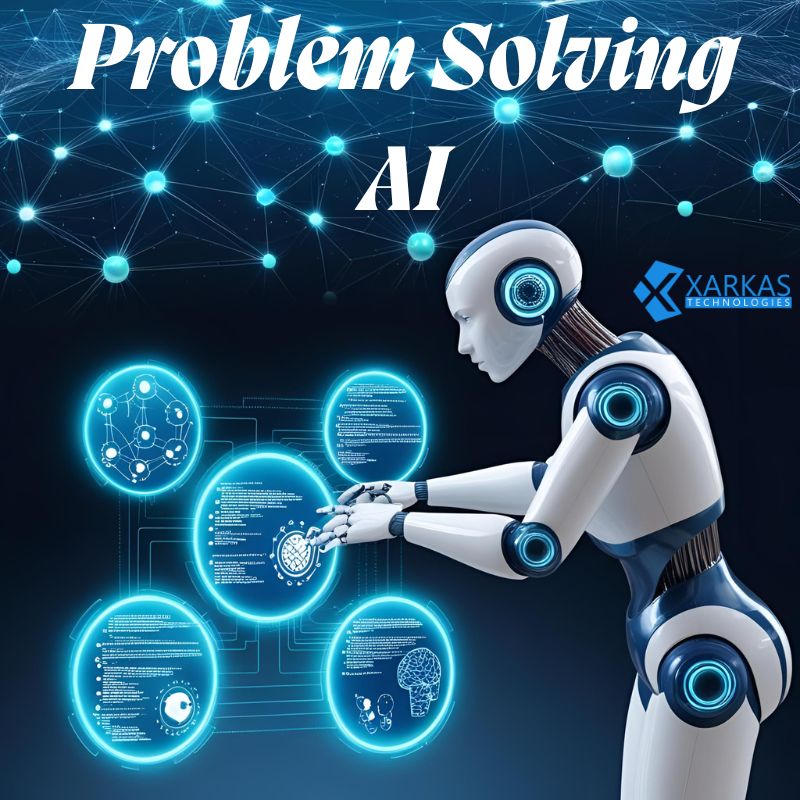
Problem Solving in AI: Strategies, Techniques, and Real-World Applications
Artificial Intelligence (AI) has revolutionized the landscape of problem solving by enabling machines to mimic human reasoning and decision-making. In this comprehensive guide, we explore the core methodologies, techniques, and practical implementations of problem solving in AI, providing a deep dive into how intelligent systems tackle real-world challenges with precision and efficiency.
Table Of Content
- What is Problem Solving in Artificial Intelligence?
- Key Components of AI Problem Solving
- 1. Problem Definition
- 2. Search Space and State Space
- Types of Problems in AI
- 1. Deterministic vs. Non-Deterministic Problems
- 2. Static vs. Dynamic Problems
- 3. Single-Agent vs. Multi-Agent Problems
- Popular AI Problem Solving Techniques
- 1. Heuristic Search Algorithms
- 2. Uninformed Search Techniques
- 3. Constraint Satisfaction Problems (CSP)
- 4. Game Theory and Adversarial Search
- Knowledge Representation in Problem Solving
- Machine Learning in Problem Solving
- Planning in AI Problem Solving
- Real-World Applications of AI Problem Solving
- 1. Robotics
- 2. Healthcare
- 3. Natural Language Processing (NLP)
- 4. Autonomous Vehicles
- 5. Finance and Risk Management
- Challenges in AI Problem Solving
- Future Directions in AI Problem Solving
- Conclusion
What is Problem Solving in Artificial Intelligence?

Problem solving in AI refers to the methodical process by which intelligent agents identify, analyze, and resolve complex issues using algorithms, heuristics, and knowledge-based systems. It encapsulates a range of processes, from recognizing a problem to devising and implementing a solution strategy that meets defined objectives.
Key Components of AI Problem Solving
1. Problem Definition
The first step involves a clear and structured understanding of the problem. This includes:
-
Initial State: Where the system starts
-
Goal State: The desired outcome
-
Operators: Actions that transition between states
-
Constraints: Conditions that must be satisfied
2. Search Space and State Space
The search space encompasses all possible configurations of the system from the initial to the goal state. State space is the subset navigated through defined rules. Efficient problem solvers use intelligent search algorithms to navigate this space.
Types of Problems in AI
1. Deterministic vs. Non-Deterministic Problems
-
Deterministic Problems offer predictable outcomes, often tackled with exact algorithms.
-
Non-Deterministic Problems involve uncertainty, requiring probabilistic models.
2. Static vs. Dynamic Problems
-
Static Problems do not change during computation.
-
Dynamic Problems evolve over time, demanding real-time adaptation.
3. Single-Agent vs. Multi-Agent Problems
-
Single-Agent Systems operate independently.
-
Multi-Agent Systems involve coordination, competition, or collaboration between multiple intelligent agents.
Popular AI Problem Solving Techniques
1. Heuristic Search Algorithms
Heuristics guide the search process by estimating the most promising path. Techniques include:
-
A* Search: Combines path cost and heuristic estimate for optimal efficiency.
-
Greedy Best-First Search: Selects paths based on estimated cost to goal.
-
Hill Climbing: Moves in the direction of increasing value without backtracking.
2. Uninformed Search Techniques
These do not have domain-specific knowledge. Examples:
-
Breadth-First Search (BFS): Explores all neighbors at the current depth before moving deeper.
-
Depth-First Search (DFS): Explores as far down a branch as possible before backtracking.
-
Uniform Cost Search: Expands the lowest-cost path node first.
3. Constraint Satisfaction Problems (CSP)
In CSPs, the goal is to find a state satisfying all constraints. Used in:
-
Scheduling
-
Planning
-
Resource allocation
4. Game Theory and Adversarial Search
Utilized in multi-agent environments such as games, using:
-
Minimax Algorithm
-
Alpha-Beta Pruning
These ensure optimal decision-making in competitive scenarios.
Knowledge Representation in Problem Solving
Knowledge representation plays a crucial role in AI problem solving. Without well-structured data and rules, intelligent reasoning is impossible. Techniques include:
-
Semantic Networks
-
Frames
-
Ontologies
-
Production Rules
These structures help agents reason, infer, and make decisions based on stored knowledge.
Machine Learning in Problem Solving
AI systems are increasingly leveraging machine learning (ML) to enhance problem-solving capabilities. ML enables systems to learn from data and improve over time.
-
Supervised Learning: Used in classification and regression tasks.
-
Unsupervised Learning: Utilized for clustering and pattern detection.
-
Reinforcement Learning: Ideal for environments where agents learn via feedback and rewards.
Incorporating ML allows AI agents to adapt to dynamic environments, self-correct errors, and optimize performance.
Planning in AI Problem Solving
Planning is essential for tasks requiring multiple steps and foresight. AI planning systems generate sequences of actions that transform the initial state to the goal state efficiently.
Types of planning:
-
Classical Planning: Assumes a static world, complete knowledge, and deterministic actions.
-
Conditional Planning: Accounts for uncertainty and incomplete information.
-
Hierarchical Task Network (HTN) Planning: Breaks down tasks into subtasks for easier execution.
Real-World Applications of AI Problem Solving
1. Robotics
Robots use AI for path planning, object recognition, and task automation in manufacturing, logistics, and healthcare.
2. Healthcare
AI diagnoses diseases, recommends treatments, and forecasts patient outcomes by solving complex medical problems using data-driven models.
3. Natural Language Processing (NLP)
AI solves language understanding challenges through sentiment analysis, translation, and chatbots powered by transformer models and deep learning.
4. Autonomous Vehicles
Self-driving cars solve real-time navigation and decision-making challenges using AI algorithms that process sensor data, predict obstacles, and determine optimal routes.
5. Finance and Risk Management
AI identifies fraud, predicts market trends, and automates trading strategies through sophisticated problem-solving models based on historical data and economic indicators.
Challenges in AI Problem Solving
Despite its potential, AI problem solving faces several hurdles:
-
Scalability: Some algorithms struggle with large-scale data and problems.
-
Uncertainty Handling: Probabilistic reasoning is still imperfect.
-
Ethical Concerns: Decision-making must align with societal norms.
-
Data Quality: Poor data leads to flawed models and outcomes.
Addressing these issues requires ongoing innovation and ethical frameworks to guide AI development.
Future Directions in AI Problem Solving
The evolution of AI will increasingly rely on hybrid approaches combining symbolic reasoning with neural networks, also known as neuro-symbolic AI. Integration with quantum computing and advancements in transfer learning will also redefine the boundaries of AI’s problem-solving capabilities.
Emerging trends include:
-
Explainable AI (XAI) for transparency
-
Federated Learning for privacy-preserving model training
-
Meta-Learning to learn how to learn
Conclusion
Problem solving in AI is the bedrock of intelligent systems. From heuristic search algorithms and constraint satisfaction to machine learning and planning, AI employs a diverse arsenal to address challenges across domains. As technology advances, AI’s capacity to solve problems with increasing complexity, speed, and precision continues to reshape industries and redefine possibilities.







No Comment! Be the first one.